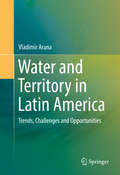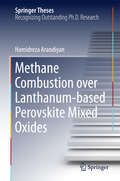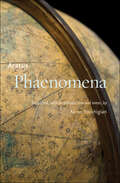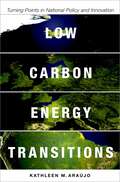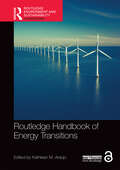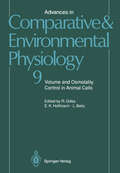- Table View
- List View
Environmental Modeling and Health Risk Analysis (Acts/Risk)
by Mustafa Aral ARALEnvironmental Modeling and Health Risk Analysis (ACTS/RISK) The purpose of this book is to provide the reader with an integrated perspective on several ?elds. First, it discusses the ?elds of environmental modeling in general and multimedia (the term “multimedia” is used throughout the text to indicate that environmental transformation and transport processes are discussed in association with three environmental media: air, groundwater and surface water pathways) environmental transformation and transport processes in particular; it also provides a detailed description of numerous mechanistic models that are used in these ?elds. Second, this book presents a review of the topics of exposure and health risk analysis. The Analytical Contaminant Transport Analysis System (ACTS) and Health RISK Analysis (RISK) software tools are an integral part of the book and provide computational platforms for all the models discussed herein. The most recent versions of these two software tools can be downloaded from the publisher’s web site. The author recommends registering the software on the web download page so that users can receive updates about newer versions of the software.
Water and Territory in Latin America: Trends, Challenges and Opportunities
by Vladimir AranaThis book focuses in the current situation of water resources, water supply and sanitation, and population movement in Latin America. It identifies new phenomena and challenges that will put more pressure on water resources in the near future and that will create important socioeconomic constraints in population and their governments. This volume offers an evaluation of water resources availability and consumption, water supply and sanitation shortages, management models and population growth and territory occupation trends in eighteen Latin American countries. Also a set of recommendations, policy proposals and projects is outlined.
3,000 Deep-Sky Objects: An Annotated Catalogue (The Patrick Moore Practical Astronomy Series)
by Ted ArandaThis title is a comprehensive set of visual descriptions of deep-sky objects visible from the northern hemisphere. It is a record of the most extensive and systematic visual survey of the sky ever done in modern times. 3,000 deep-sky objects are listed with short descriptions of the visual appearance in the author's powerful binocular telescope. Objects in the book are organized by position for easy identification of unknown targets. Full indexes by catalog numbers and names allow searches for specific objects.
Mechanobiology of the Endothelium
by Helim Aranda-EspinozaThe endothelium is an excellent example of where biology meets physics and engineering. It must convert mechanical forces into chemical signals to maintain homeostasis. It also controls the immune response, drug delivery through the vasculature, and cancer metastasis. Basic understanding of these processes is starting to emerge and the knowledge ga
Methane Combustion over Lanthanum-based Perovskite Mixed Oxides (Springer Theses)
by Hamidreza ArandiyanThis book presents current research into the catalytic combustion of methane using perovskite-type oxides (ABO3). Catalytic combustion has been developed as a method of promoting efficient combustion with minimum pollutant formation as compared to conventional catalytic combustion. Recent theoretical and experimental studies have recommended that noble metals supported on (ABO3) with well-ordered porous networks show promising redox properties. Three-dimensionally ordered macroporous (3DOM) materials with interpenetrated and regular mesoporous systems have recently triggered enormous research activity due to their high surface areas, large pore volumes, uniform pore sizes, low cost, environmental benignity, and good chemical stability. These are all highly relevant in terms of the utilization of natural gas in light of recent catalytic innovations and technological advances. The book is of interest to all researchers active in utilization of natural gas with novel catalysts. The research covered comes from the most important industries and research centers in the field. The book serves not only as a text for researcher into catalytic combustion of methane, 3DOM perovskite mixed oxide, but also explores the field of green technologies by experts in academia and industry. This book will appeal to those interested in research on the environmental impact of combustion, materials and catalysis.
Electrical Safety Engineering of Renewable Energy Systems (IEEE Press)
by Rodolfo Araneo Massimo MitoloElectrical Safety Engineering of Renewable Energy Systems A reference to designing and developing electrical systems connected to renewable energies Electrical Safety Engineering of Renewable Energy Systems is an authoritative text that offers an in-depth exploration to the safety challenges of renewable systems. The authors—noted experts on the topic—cover a wide-range of renewable systems including photovoltaic, wind, and cogeneration and propose a safety-by-design approach. The book clearly illustrates safe behavior in complex real-world renewable energy systems using practical approaches. The book contains a review of the foundational electrical engineering topics and highlights how safety engineering links to the renewable energies. Designed as an accessible resource, the text discusses the most relevant and current topics supported by rigorous analytical, theoretical and numerical analyses. The authors also provide guidelines for readers interested in practical applications. This important book: Reviews of the major electrical engineering topics Shows how safety engineering links to the renewable energies Discusses the most relevant current topics in the field Provides solid theoretical and numerical explanations Written for students and professional electrical engineers, Electrical Safety Engineering of Renewable Energy Systems explores the safety challenges of renewable systems and proposes a safety-by-design approach, which is currently missing in current literature.
Electrical Safety Engineering of Renewable Energy Systems (IEEE Press)
by Rodolfo Araneo Massimo MitoloElectrical Safety Engineering of Renewable Energy Systems A reference to designing and developing electrical systems connected to renewable energies Electrical Safety Engineering of Renewable Energy Systems is an authoritative text that offers an in-depth exploration to the safety challenges of renewable systems. The authors—noted experts on the topic—cover a wide-range of renewable systems including photovoltaic, wind, and cogeneration and propose a safety-by-design approach. The book clearly illustrates safe behavior in complex real-world renewable energy systems using practical approaches. The book contains a review of the foundational electrical engineering topics and highlights how safety engineering links to the renewable energies. Designed as an accessible resource, the text discusses the most relevant and current topics supported by rigorous analytical, theoretical and numerical analyses. The authors also provide guidelines for readers interested in practical applications. This important book: Reviews of the major electrical engineering topics Shows how safety engineering links to the renewable energies Discusses the most relevant current topics in the field Provides solid theoretical and numerical explanations Written for students and professional electrical engineers, Electrical Safety Engineering of Renewable Energy Systems explores the safety challenges of renewable systems and proposes a safety-by-design approach, which is currently missing in current literature.
Handbook of Cell and Gene Therapy: From Proof-of-Concept through Manufacturing to Commercialization
by Hazel Aranha Humberto Vega-MercadoThis handbook provides an in-depth review of information across the developmental spectrum of gene and cell therapy products. From introductory information to state-of-the-art technologies and concepts, the book provides insights into upstream processes such as vector design and construction, purification, formulation and fill/finish as well as delivery options. Planning steps for compliance with current good manufacturing practice (CGMP) to readiness for chemistry, manufacturing, and controls (CMC) are also discussed.This book wraps up with examples of successes and pitfalls addressed by experts who have navigated the multiple challenges that are part of any innovative endeavor. Features Intended as a one-stop resource for availability of state-of-the-art information related to cell and gene therapy products for researchers, scientists, management and other academic and research institutions. Provides the most up to date information on the development of gene therapy, from the technology involved to gene correction and genome editing. Discusses siRNA, mRNA, and plasmid manufacturing. Describes the importance of supplier-sponsor synergies on the path to commercialization. Diverse audience with a large number of individuals in the core technologies and supportive practices.
Field Guidelines for Genetic Experimental Designs in High-Throughput Sequencing
by Ana M. Aransay José Luis Lavín TruebaHigh throughput sequencing (HTS) technologies have conquered the genomics and epigenomics worlds. The applications of HTS methods are wide, and can be used to sequence everything from whole or partial genomes, transcriptomes, non-coding RNAs, ribosome profiling, to single-cell sequencing. Having such diversity of alternatives, there is a demand for information by research scientists without experience in HTS that need to choose the most suitable methodology or combination of platforms and to define their experimental designs to achieve their specific objectives. Field Guidelines for Genetic Experimental Designs in High-Throughput Sequencing aims to collect in a single volume all aspects that should be taken into account when HTS technologies are being incorporated into a research project and the reasons behind them. Moreover, examples of several successful strategies will be analyzed to make the point of the crucial features. This book will be of use to all scientist that are unfamiliar with HTS and want to incorporate such technologies to their research.
Physical Models of Cell Motility (Biological and Medical Physics, Biomedical Engineering)
by Igor S. AransonThis book surveys the most recent advances in physics-inspired cell movement models. This synergetic, cross-disciplinary effort to increase the fidelity of computational algorithms will lead to a better understanding of the complex biomechanics of cell movement, and stimulate progress in research on related active matter systems, from suspensions of bacteria and synthetic swimmers to cell tissues and cytoskeleton.Cell motility and collective motion are among the most important themes in biology and statistical physics of out-of-equilibrium systems, and crucial for morphogenesis, wound healing, and immune response in eukaryotic organisms. It is also relevant for the development of effective treatment strategies for diseases such as cancer, and for the design of bioactive surfaces for cell sorting and manipulation. Substrate-based cell motility is, however, a very complex process as regulatory pathways and physical force generation mechanisms are intertwined. To understand the interplay between adhesion, force generation and motility, an abundance of computational models have been proposed in recent years, from finite element to immerse interface methods and phase field approaches.This book is primarily written for physicists, mathematical biologists and biomedical engineers working in this rapidly expanding field, and can serve as supplementary reading for advanced graduate courses in biophysics and mathematical biology. The e-book incorporates experimental and computer animations illustrating various aspects of cell movement.
Advances in Dynamics, Patterns, Cognition: Challenges in Complexity (Nonlinear Systems and Complexity #20)
by Igor S. Aranson Arkady Pikovsky Nikolai F. Rulkov Lev S. TsimringThis book focuses on recent progress in complexity research based on the fundamental nonlinear dynamical and statistical theory of oscillations, waves, chaos, and structures far from equilibrium. Celebrating seminal contributions to the field by Prof. M. I. Rabinovich of the University of California at San Diego, this volume brings together perspectives on both the fundamental aspects of complexity studies, as well as in applications in different fields ranging from granular patterns to understanding of the cognitive brain and mind dynamics. The slate of world-class authors review recent achievements that together present a broad and coherent coverage of modern research in complexity greater than the sum of its parts.
Ecotoxicology, Ecological Risk Assessment and Multiple Stressors (Nato Security through Science Series C:)
by Gerassimos Arapis Philippe Baveye Nadezhda GoncharovaThe science of ecotoxicology and the practice of ecological risk assessment are evolving rapidly. Ecotoxicology as a subject area came into prominence in the 1960s after the publication of Rachel Carson's book on the impact of pesticides on the environment. The rise of public and scientific concern for the effects of chemical pollutants on the environment in the 1960s and 1970s led to the development of the discipline of ecotoxicology, a science that takes into account the effects of chemicals in the context of ecology. Until the early 1980s, in spite of public concern and interest among scientists, the assessment of ecological risks associated with natural or synthetic pollutants was not considered a priority issue by most government. However, as the years passed, a better understanding of the importance of ecotoxicology emerged and with it, in some countries, the progressive formalization of an ecological risk assessment process. Ecological risk assessment is a conceptual tool for organizing and analyzing data and information to evaluate the likelihood that one or more stressors are causing or will cause adverse ecological effects. Ecological risk assessment allows risk managers to consider available scientific information when selecting a course of action, in addition to other factors that may affect their decision (e. g. , social, legal, political, or economic). Ecological risk assessment includes three phases (problem formulation, analysis, and risk characterization).
Business Against Intimate Partner Violence: A Case of Participatory Action Research and Social Action (Accounting, Finance, Sustainability, Governance & Fraud: Theory and Application)
by Melsa AraratThis book addresses the Business Against Domestic Violence (BADV) project launched by the Corporate Governance Forum of Turkey (CGFT), a research center at Sabanci University School of Management. The goal of BADV is to mobilize companies to combat intimate partner violence (IPV) in Turkey. The project was made possible by a collaborative partnership with the United Nations Population Fund (UNFPA) and the Turkish Industrialists and Business Association (TUSIAD). The book is divided into two sections. Section 1, which focuses on the project itself, frames the elimination of IPV as an SDG target, and provides a detailed account of the project’s motivation, underlying research, project organization, implementation, and outcome. The question of why gender equality and IPV matter for business is also addressed. Lastly, the role of business schools and management scholars in creating practical and actionable knowledge to achieve development goals is discussed, based on the BADV experience. In turn, Section 2 explores the background of the project and sheds a multidisciplinary light on the local context. The main objective of the book is to encourage business schools and business organizations to form partnerships in pursuit of Goal-5 and other SDG targets, helping to create actionable knowledge and prompt social action. The book presents IPV from all relevant perspectives and focuses on Turkey, a key emerging economy and G-20 country.
Computational Transport Phenomena of Fluid-Particle Systems (Mechanical Engineering Series)
by Hamid Arastoopour Dimitri Gidaspow Emad AbbasiThis book concerns the most up-to-date advances in computational transport phenomena (CTP), an emerging tool for the design of gas-solid processes such as fluidized bed systems. The authors examine recent work in kinetic theory and CTP and illustrate gas-solid processes’ many applications in the energy, chemical, pharmaceutical, and food industries. They also discuss the kinetic theory approach in developing constitutive equations for gas-solid flow systems and how it has advanced over the last decade as well as the possibility of obtaining innovative designs for multiphase reactors, such as those needed to capture CO2 from flue gases. Suitable as a concise reference and a textbook supplement for graduate courses, Computational Transport Phenomena of Gas-Solid Systems is ideal for practitioners in industries involved with the design and operation of processes based on fluid/particle mixtures, such as the energy, chemicals, pharmaceuticals, and food processing.
Transport Phenomena in Multiphase Systems (Mechanical Engineering Series)
by Hamid Arastoopour Dimitri Gidaspow Robert W. LyczkowskiThis volume fills the need for a textbook presenting basic governing and constitutive equations, followed by several engineering problems on multiphase flow and transport that are not provided in current advanced texts, monographs, or handbooks. The unique emphasis of this book is on the sound formulation of the basic equations describing multiphase transport and how they can be used to design processes in selected industrially important fields. The clear underlying mathematical and physical bases of the interdisciplinary description of multiphase flow and transport are the main themes, along with advances in the kinetic theory for particle flow systems. The book may be used as an upper-level undergraduate or graduate textbook, as a reference by professionals in the design of processes that deal with a variety of multiphase systems, and by practitioners and experts in multiphase science in the area of computational fluid dynamics (CFD) at U.S. national laboratories, international universities, research laboratories and institutions, and in the chemical, pharmaceutical, and petroleum industries. Distinct from other books on multiphase flow, this volume shows clearly how the basic multiphase equations can be used in the design and scale-up of multiphase processes. The authors represent a combination of nearly two centuries of experience and innovative application of multiphase transport representing hundreds of publications and several books. This book serves to encapsulate the essence of their wisdom and insight, and:
Phaenomena (Johns Hopkins New Translations from Antiquity)
by AratusAfter the Iliad and the Odyssey, the Phaenomena was the most widely read poem in the ancient world. Its fame was immediate. It was translated into Latin by Ovid and Cicero and quoted by St. Paul in the New Testament, and it was one of the few Greek poems translated into Arabic. Aratus’ Phaenomena is a didactic poem—a practical manual in verse that teaches the reader to identify constellations and predict weather. The poem also explains the relationship between celestial phenomena and such human affairs as agriculture and navigation. Despite the historical and pedagogical importance of the poem, no English edition suitable for students and general readers has been available for decades. Aaron Poochigian’s lively translation makes accessible one of the most influential poets of antiquity. Poochigian's interpretation of the Phaenomena reestablishes the ancient link between poetry and science and demonstrates that verse is an effective medium for instruction. Featuring references to Classical mythology and science, star charts of the northern and southern skies, extensive notes, and an introduction to the work’s stylistic features and literary reception, this dynamic work will appeal to students of Ancient Greece who want to deepen their understanding of the Classical world.
Smart Structures and Materials: Selected Papers from the 7th ECCOMAS Thematic Conference on Smart Structures and Materials (Computational Methods in Applied Sciences #43)
by Aurelio L. Araujo Carlos A. Mota SoaresThis work was compiled with expanded and reviewed contributions from the 7th ECCOMAS Thematic Conference on Smart Structures and Materials, that was held from 3 to 6 June 2015 at Ponta Delgada, Azores, Portugal. The Conference provided a comprehensive forum for discussing the current state of the art in the field as well as generating inspiration for future ideas specifically on a multidisciplinary level. The scope of the Conference included topics related to the following areas:Fundamentals of smart materials and structures; Modeling/formulation and characterization of smart actuators, sensors and smart material systems; Trends and developments in diverse areas such as material science including composite materials, intelligent hydrogels, interfacial phenomena, phase boundaries and boundary layers of phase boundaries, control, micro- and nano-systems, electronics, etc. to be considered for smart systems; Comparative evaluation of different smart actuators and sensors; Analysis of structural concepts and designs in terms of their adaptability to smart technologies; Design and development of smart structures and systems; Biomimetic phenomena and their inspiration in engineering; Fabrication and testing of smart structures and systems; Applications of smart materials, structures and related technology; Smart robots; Morphing wings and smart aircrafts; Artificial muscles and biomedical applications; Smart structures in mechatronics; and Energy harvesting.
Low Carbon Energy Transitions: Turning Points in National Policy and Innovation
by Kathleen AraújoThe world is at a pivotal crossroad in energy choices. There is a strong sense that our use of energy must be more sustainable. Moreover, many also broadly agree that a way must be found to rely increasingly on lower carbon energy sources. However, no single or clear solution exists on the means to carry out such a shift at either a national or international level. Traditional energy planning (when done) has revolved around limited cost projections that often fail to take longer term evidence and interactions of a wider set of factors into account. The good news is that evidence does exist on such change in case studies of different nations shifting toward low-carbon energy approaches. In fact, such shifts can occur quite quickly at times, alongside industrial and societal advance, innovation, and policy learning. These types of insights will be important for informing energy debates and decision-making going forward. Low Carbon Energy Transitions: Turning Points in National Policy and Innovation takes an in-depth look at four energy transitions that have occurred since the global oil crisis of 1973: Brazilian biofuels, Danish wind power, French nuclear power, and Icelandic geothermal energy. With these cases, Dr. Araújo argues that significant nationwide shifts to low-carbon energy can occur in under fifteen years, and that technological complexity is not necessarily a major impediment to such shifts. Dr. Araújo draws on more than five years of research, and interviews with over 120 different scientists, government workers, academics, and members of civil society in completing this study. Low Carbon Energy Transitions is written for for professionals in energy, the environment and policy as well as for students and citizens who are interested in critical decisions about energy sustainability. Technology briefings are provided for each of the major technologies in this book, so that scientific and non-scientific readers can engage in more even discussions about the choices that are involved.
Low Carbon Energy Transitions: Turning Points in National Policy and Innovation
by Kathleen AraújoThe world is at a pivotal crossroad in energy choices. There is a strong sense that our use of energy must be more sustainable. Moreover, many also broadly agree that a way must be found to rely increasingly on lower carbon energy sources. However, no single or clear solution exists on the means to carry out such a shift at either a national or international level. Traditional energy planning (when done) has revolved around limited cost projections that often fail to take longer term evidence and interactions of a wider set of factors into account. The good news is that evidence does exist on such change in case studies of different nations shifting toward low-carbon energy approaches. In fact, such shifts can occur quite quickly at times, alongside industrial and societal advance, innovation, and policy learning. These types of insights will be important for informing energy debates and decision-making going forward. Low Carbon Energy Transitions: Turning Points in National Policy and Innovation takes an in-depth look at four energy transitions that have occurred since the global oil crisis of 1973: Brazilian biofuels, Danish wind power, French nuclear power, and Icelandic geothermal energy. With these cases, Dr. Araújo argues that significant nationwide shifts to low-carbon energy can occur in under fifteen years, and that technological complexity is not necessarily a major impediment to such shifts. Dr. Araújo draws on more than five years of research, and interviews with over 120 different scientists, government workers, academics, and members of civil society in completing this study. Low Carbon Energy Transitions is written for for professionals in energy, the environment and policy as well as for students and citizens who are interested in critical decisions about energy sustainability. Technology briefings are provided for each of the major technologies in this book, so that scientific and non-scientific readers can engage in more even discussions about the choices that are involved.
Routledge Handbook of Energy Transitions (Routledge Environment and Sustainability Handbooks)
by Kathleen AraújoThe Routledge Handbook of Energy Transitions draws upon a unique and multidisciplinary network of experts from around the world to explore the expanding field of energy transitions.This Handbook recognizes that considerable changes are underway or are being developed for the modes in which energy is sourced, delivered, and utilized. Employing a sociotechnical approach that accounts for economics and engineering, as well as more cross-cutting factors, including innovation, policy and planning, and management, the volume considers contemporary ideas and practices that characterize the field. The book explores pressing issues, including choices about infrastructure, the role of food systems and materials, sustainability, and energy democracy. Disruption is a core theme throughout, with the authors examining topics such as digitalization, extreme weather, and COVID-19, along with regional similarities and differences. Overall, the Routledge Handbook of Energy Transitions advances the field of energy transitions by connecting ideas, taking stock of empirical insights, and challenging how we think about the theory and practice of energy systems change.This innovative volume functions as an authoritative roadmap with both regional and global relevance. It will be an essential resource for students, policymakers, researchers, and practitioners researching and working in the fields of energy transitions, planning, environmental management and policy, sustainable business, engineering, science and technology studies, political science, geography, design anthropology, and environmental justice.“With the exception of Chapter 26, no part of this book may be reprinted or reproduced or utilised in any form or by any electronic, mechanical, or other means, now known or hereafter invented, including photocopying and recording, or in any information storage or retrieval system, without permission in writing from the publishers.” Chapter 26 of this book is freely available as a downloadable Open Access PDF at http://www.taylorfrancis.com under a Creative Commons [Attribution-Non Commercial-No Derivatives (CC-BY-NC-ND)] 4.0 license.
Routledge Handbook of Energy Transitions (Routledge Environment and Sustainability Handbooks)
by Kathleen M. AraújoThe Routledge Handbook of Energy Transitions draws upon a unique and multidisciplinary network of experts from around the world to explore the expanding field of energy transitions.This Handbook recognizes that considerable changes are underway or are being developed for the modes in which energy is sourced, delivered, and utilized. Employing a sociotechnical approach that accounts for economics and engineering, as well as more cross-cutting factors, including innovation, policy and planning, and management, the volume considers contemporary ideas and practices that characterize the field. The book explores pressing issues, including choices about infrastructure, the role of food systems and materials, sustainability, and energy democracy. Disruption is a core theme throughout, with the authors examining topics such as digitalization, extreme weather, and COVID-19, along with regional similarities and differences. Overall, the Routledge Handbook of Energy Transitions advances the field of energy transitions by connecting ideas, taking stock of empirical insights, and challenging how we think about the theory and practice of energy systems change.This innovative volume functions as an authoritative roadmap with both regional and global relevance. It will be an essential resource for students, policymakers, researchers, and practitioners researching and working in the fields of energy transitions, planning, environmental management and policy, sustainable business, engineering, science and technology studies, political science, geography, design anthropology, and environmental justice.“With the exception of Chapter 26, no part of this book may be reprinted or reproduced or utilised in any form or by any electronic, mechanical, or other means, now known or hereafter invented, including photocopying and recording, or in any information storage or retrieval system, without permission in writing from the publishers.” Chapter 26 of this book is freely available as a downloadable Open Access PDF at http://www.taylorfrancis.com under a Creative Commons [Attribution-Non Commercial-No Derivatives (CC-BY-NC-ND)] 4.0 license.
Strategies and Tools for Pollutant Mitigation: Avenues to a Cleaner Environment
by J. Aravind M. Kamaraj M. Prashanthi Devi S. RajakumarThis volume explores recent research trends and achievements in environmental pollution remediation (e.g. water, air, soil), and compiles critical and constructive papers and reviews with a focus on advances in bioremediation and green technology solutions for waste minimization, waste management and pollution control. The book is timely, as the need for researchers and engineers to develop sustainable and green eco-friendly remediation technologies is increasing with a growing global population, stressed agricultural systems, and an environment impacted by climate change. A key focus of the book is on the efficient use of agricultural waste residues as viable substrates for creating materials for environmental clean-up, and the possible conversion of these pollutants to sustainable bioresources. The volume will be of interest to sustainability researchers, environmental engineers, industry managers and agricultural scientists.
Strategies and Tools for Pollutant Mitigation: Research Trends in Developing Nations
by J. Aravind M. Kamaraj S. KarthikeyanThis book offers an overview of the latest work in environmental remediation and waste management coming out of developing nations. It is split into two sections: one on state-of-the-art sustainable remediation approaches, and the other covering waste management for a cleaner environment The ten chapters in this book are structured as reviews that assimilate recent works in these areas; they provide a centralized resource for scholars in developing nations who are working in environmental remediation and waste management. The volume will be of interest to sustainability researchers, environmental engineers, industry managers and agricultural scientists.
Advances in Comparative and Environmental Physiology: Volume and Osmolality Control in Animal Cells (Advances in Comparative and Environmental Physiology #9)
by T. Arawaka M. B. Burg H. F. Cserr J. J. Grantham S. Grinstein E. K. Hoffmann H. K. Kimelberg H. A. Kolb R. O. Law J. W. Lohr A.D.C. Macknight M. J. Mason C. S Patlak D. Rotin S. N. TimasheffAdvances in Compararative and Environmental Physiology helps biologists, physiologists, and biochemists keep track of the extensive literature in the field. Providing comprehensive, integrated reviews and sound, critical, and provocative summaries, this series is a must for all active researchers in environmental and comparative physiology. Cellular volume and osmolality in animals is a well studied topic and this specific volume in the series provides the reader with a thorough grounding in this area of physiology. Consisting of two parts, the text discusses osmolality and volume control in terms of both inorganic and organic ions which as a result gives an excellent overview to those working and interested in this field.
The Response of Western Forests to Air Pollution (Ecological Studies #97)
by M. Arbaugh Dan Binkley Margi Böhm L. Brubaker A. Bytnerowicz S. Cline E. Cook T. Droessler D. Duriscoe C. Earle D. Ford D. Graybill N. Grulke J. Miller P. Miller Richard K. Olson D. Peterson C. Ribic M. Rose G. Segura K. Stolte S. Vega-GonzalezJohn Sculley In the short history of personal computing, the task of the software programmer has been one of the least recognized-but one of the most significant-in the industry. In addition to defining the prob lems, and presenting the solutions, the software programmer is con fronted with the challenge of having to predict what combination of ideas and technologies will move the industry forward in the most compelling way. Even though we've seen the development of tremendous applications in a surprisingly short period of time, the most difficult problems often surface when we try to elevate a suc cessful local idea to the international arena. In the case of Apple Computer, these challenges become especially profound when you consider that Apple sells Macintosh not just in the United States, but in Japan, China, the Middle East, Africa, East ern Europe, and even to the United Nations itself. Of course, this means that the personal computer must work everywhere around the world. But more significantly, it also means that the software must reflect the uniqueness of a given culture, its language, morals, and even its sense of humor. To step away from a narrowly-defined, nationally-based paradigm for software development, programmers, management, and entire corporations must learn to recognize what elements of an interface, problem solving technique, documentation illustration, package de sign, and advertisement are local, and which elements are appro priate for global markets.

